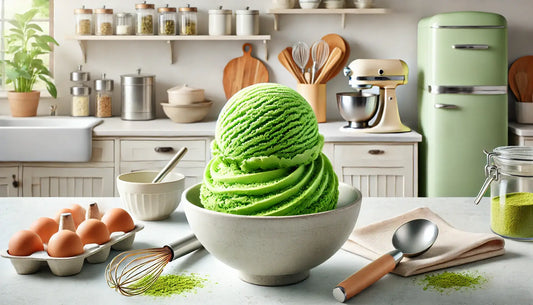What is green tea and why is it so special? 🍃
It seems like green tea is this magical green elixir that can help with everything from weight loss to stress management, but what is it exactly?
In this article, we’re going to answer the question what is green tea once and for all. We’ll show you how green tea is made, the different types of green tea and how green tea can vary depending on where it's made.
Let’s get started! 🍵
What is Green Tea Video
What is green tea?
So what is green tea exactly? Green tea is one of the six major types of teas, a group that includes white tea, yellow tea, green tea, oolong tea, red tea and dark tea.
These tea types are defined not by the plant that they comes from, but how they are processed.
One plant to rule them all

All true teas come from the tea plant, camelia sinensis. This is an evergreen, flowering shrub that is native to southern China. If allowed to grow naturally, the tea plant can reach heights of up to 30 feet, but they are normally pruned shorter.
The leaves naturally develop caffeine as a defense mechanism to protect against insects, so all true teas contain some level of caffeine.
Differences between tea types
As we will get into more detail later, the differences between the tea types come from how they are processed. You will also be able to see the differences by looking at the teas and tasting the teas.
By the way, if you want to see how matcha powder differs from a regular green tea, you should read this article 👉 10 Difference between Matcha and Green Tea
What is green tea known for?
So what is green tea known for amongst tea connoisseurs? In other words, when tea drinkers think of green tea in terms of its appearance and flavor, what comes to mind first?
What is green tea known for in terms of flavor?
So what is green tea known for in terms of its taste profile? Green tea has a fresh, vegetal and slightly citrusy taste profile. There are certain steps taken in the production process to lock in the natural characteristics of the leaf, and therefore it tastes more “natural”.
If you want to hear a more in-depth description for the flavor, you can read this article 👉 What does green tea taste like?
What is green tea known for in terms of appearance?
What is green tea known for in terms of appearance? While some green teas have a green colored infusion, most of them are yellow. The name “green tea” is a reference to the green color of the leaves.
What is green tea made from?
Now that we’ve briefly discussed what is green tea and what is green tea known for, let’s jump into the details and see what is green tea made from?
The short answer is that green tea is made from unoxidized tea leaves, but how exactly are they produced? Let’s find out! 👨🏻🌾
Harvesting
 Before the tea can be made, it needs to be harvested. The part of the plant used for the tea will determine a lot about its flavor.
Before the tea can be made, it needs to be harvested. The part of the plant used for the tea will determine a lot about its flavor.So what is green tea made from in terms of picking? Generally it is made using the young sprouts of the tea plant.
These young sprouts are the highest in nutrients and the sweetest in flavor.
There are also green teas like bancha that are made from the older leaves of the tea plant.
Heating

This is where the magic happens. After the leaves are harvested they will begin to oxidize naturally and eventually turn into a black tea.
In order to stop the oxidation process, the leaves need to be heated within few hours after the harvest.
This deactivates the enzymes that cause oxidation, and allows the tea to maintain more of its natural vegetal flavors.
In Japan, the heat is applied through steam and in China the heat is generally applied by heating the leaves in a large pan.

Rolling
After the leaves have been heated, they are taken through a long drying process and while they are still pliable, they are rolled into different shapes.
This rolling allows the producer to lock in the flavor of the tea, until it is ready to be infused into water.
The shapes the tea leaves are rolled into are dependent upon what type of tea is being produced.
What is green tea - broken down by type
The question what is green tea is almost too broad. It’s best to break it down by different types. Let’s go through some of the basic types of green tea to see how “what is green tea” can take on many different definitions.
8 Types of Green Tea you should know
Sencha

When you ask what is green tea, one of the first teas to come to mind is sencha tea. This is the most common type of green tea in Japan and it was the first type of loose leaf tea consumed there.
This tea is made from leaves that have been steamed, rolled and dried.
It can take on a vast array of different flavors, with everything from the smooth and fruity fukamushi sencha teas to the slightly dry unshaded senchas.
Bancha
Bancha is the second most popular type of green tea in Japan. As we mentioned before, this tea is made from the older leaves of the tea plant.
The older leaves are lower in caffeine and higher in minerals, which makes bancha a good tea for after a meal.
This tea takes on a slightly earthier taste profile, with a hint of wood and citrus. It is also much less expensive, so it can be bought at a fraction of the price of sencha.
Gyokuro
Gyokuro is known as the emperor’s tea, because it used to be the tea of choice for the emperor himself. This tea goes through a long and labor intensive production process in order to take on its trademark sweet and savory flavor.
The taste of this tea is unlike any other, and it all comes down to the high l-theanine content of the tea. This l-theanine is thought to induce a calming effect on the brain, and this is why gyokuro drinkers report having a long lasting, calm-alert energy throughout the day.
Hojicha

What is green tea when it is roasted? Does it become a black tea? The answer is no! Although roasted green teas like hojicha may look like a black tea, it is actually an unoxidized green tea.
After the tea leaves have been picked, steamed and dried, they are gathered up and roasted in a large pan. During the roasting process, the color of the leaf fades from green tea brown, and the flavor takes on warmer profiles of coffee, caramel and chocolate!
Matcha

What is green tea when it is ground into a powder? The answer is matcha! Matcha powder has taken the world by storm, but it actually has been used for centuries. It’s most famous use is in the Japanese tea ceremony.
Because this tea is mixed directly into water rather than infused, you are consuming the entire leaf. This means you are getting a higher dose of caffeine, amino acids and theanine per sip than any other tea. This makes matcha a nutritional powerhouse!
Genmaicha

The question of what is green tea takes on a bit of a twist when it is blended with other ingredients. In the case of genmaicha, green tea is blended with toasted rice.
This began as a way to conserve resources during times of famine, but now it has become a successful tea in its own right.
The rice gives the tea a lower caffeine content and a pleasant flavor of warm cereal or toasted nuts.
Kukicha

So what is green tea when it is made from the stems of the tea plant? You end up with kukicha, also known as stem tea or twig tea. The stems have a lower caffeine content, a higher mineral content and a mild, straw flavor.
This is a really enjoyable tea, and because it is lower in caffeine you can drink it much later in the day without being kept up all night.
What is green tea in different regions
The question “what is green tea” can get different answers depending on what part of the world you are in. Let’s go through 2 different countries that are famous for their production of green tea and see how green tea can vary depending on where you are.
If you're interested in learning what makes Japanese green tea different from green teas in other regions, you might like our guide 👉 8 Basic Types of Japanese Green Tea
What is green tea in China?
In China, green teas are typically heated in a large pan in order to stop the oxidation process. This imparts more of these “cooked” notes onto the leaves. You might get slightly nutty, caramel flavors from the teas.
There is a type of Japanese tea called Kamairicha that is made using the Chinese style and it shares a similar taste characteristic. While this tea is rare in Japan as a whole, there are some farmers like Mr. Issin in Takachiho that still make it the traditional way.
What is green tea in Japan?
In Japan, green tea is steamed after the harvest. This locks in more of the vegetal characteristics of the tea and as a result, Japanese green teas take on these “steamed vegetable” characteristics. They can also take on a vibrant green color.
Fukamushi sencha is steamed for a longer time. During this time, the tea leaves are broken down even further and when the tea is brewed, more of the leaf flows into the cup. This creates a cloudy green infusion and a smooth, fruity flavor in the case of the Yamaga no Sato.
What is green tea used for?
So what is green tea helpful for? Green tea can have a plethora of health benefits, with the most interesting being weight loss, concentration and cold and flu prevention.
Catechins for weight loss and flu prevention
The catechins in the green tea have been known to help prevent illness and lessen its symptoms. They have also been shown to increase fat oxidation and lead to more weight loss when combined with moderate exercise.
If you want to find the best green tea for cold and flu season, we recommend you checkout this guide 👉 The Ultimate Guide for Cold and Flu Tea
Caffeine and L-Theanine for Concentration
There are are a lot of caffeinated beverages out there so what is green tea so good for? Green tea contains l-theanine which is thought to buffer some of the negative side effects of caffeine.
This means instead of getting a rapid jolt of energy and a crash later on, you’ll get a longer lasting, calm alert sensation that lasts throughout the day. This makes green tea a great choice for long periods of work, study and exercise.
If you're looking for high caffeine teas, we have the perfect guide for you! Checkout our breakdown of 👉 Which tea has the most caffeine
What is green tea - The Final Verdict
The question what is green tea can vary depending on region, tea type and processing method, but in the end green tea is a delicious, healthy beverage that is enjoyed by people all around the world.
Green tea can be grown and harvested in different ways to produce different shapes, flavors and health benefits.
This means that you can study green tea for a lifetime and still not have all the answers! If you're interested about the different side effect of green tea, make sure to read 👉 Avoiding Green Tea Side Effects: What You Need To Know
I hope this article has helped you at least get closer to understanding what is green tea and why it is so special.






